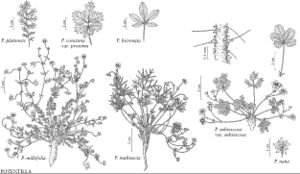Potentilla bicrenata
Bull. Torrey Bot. Club 23: 431. 1896.
Stems 0.2–0.8 (–1.5) dm, lengths 1/2–1 1/2 times basal leaves. Basal leaves palmate, (2–) 4–10 (–15) cm; petiole (1–) 2–6 (–10) cm, straight hairs abundant, ± appressed to ascending, 1.5–2 mm, stiff, cottony hairs usually absent, glands sparse, often obscured; leaflets 5–7 (–9), on tip or at least less than distal 1/10 of leaf axis, slightly overlapping, proximal pair separated from others by 0 (–1) mm of leaf axis, central leaflets ± oblanceolate, 1–4 (–5.5) × 0.5–1 cm, petiolules 0 (–3) mm, less than distal 1/5 (–1/3) of margins incised ± 1/2 to midvein, teeth 0–1 (–3) per side, separate, 0.5–2 mm, surfaces strongly to ± dissimilar, abaxial grayish white to white, straight hairs abundant, ± appressed, 1–1.5 (–2) mm, weak to stiff (especially on veins), cottony hairs common to dense, glands absent or obscured, adaxial green to grayish green, straight hairs ± abundant, appressed, 0.5–1 mm, stiff, cottony hairs absent, rarely sparse, glands absent or obscured. Inflorescences 2–5 (–8) -flowered. Pedicels 1–3 (–4.5) cm. Flowers: epicalyx bractlets ± lanceolate, 2–4 × 1 mm; hypanthium 3–4 mm diam.; sepals (2.5–) 3–5.5 mm, apex ± acute; petals 3.5–7 × 2.5–5.5 mm; filaments 1–2 mm, anthers 0.5–1 mm; carpels 10–20, styles 2 mm. Achenes 2 mm, smooth to rugose.
Phenology: Flowering early summer.
Habitat: Outcrops, dry flats, pine duff, in pine and/or juniper woodlands, sagebrush scrub
Elevation: 1900–3300 m
Distribution

Ariz., Colo., N.Mex., Utah, Wyo.
Discussion
The entire to tridentate leaflets of Potentilla bicrenata generally serve to distinguish this species from P. concinna. Unequivocal P. bicrenata is most common in Utah and the southern Rocky Mountains from New Mexico to central Colorado; in Arizona, it is documented only from the Kaibab Plateau. Wyoming populations tend to be transitional to P. concinna var. concinna in leaflet toothing and/or petal size. Some collections from as far north as Waterton Lakes National Park, Alberta, vary in the direction of P. bicrenata but are retained here in P. concinna.
Selected References
None.
Lower Taxa
"thin" is not a number."dm" is not declared as a valid unit of measurement for this property."/2-1-1/2timesbasalleaves" is not declared as a valid unit of measurement for this property."dm" is not declared as a valid unit of measurement for this property."dm" is not declared as a valid unit of measurement for this property.
